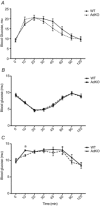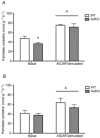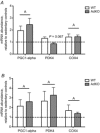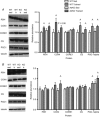Adiponectin is sufficient, but not required, for exercise-induced increases in the expression of skeletal muscle mitochondrial enzymes
- PMID: 24687585
- PMCID: PMC4080944
- DOI: 10.1113/jphysiol.2014.273680
Adiponectin is sufficient, but not required, for exercise-induced increases in the expression of skeletal muscle mitochondrial enzymes
Abstract
Adiponectin (Ad) has been proposed to be a regulator of mitochondrial biogenesis in skeletal muscle, and necessary for exercise-induced increases in mitochondrial content. We first confirmed that Ad could acutely increase the expression of mitochondrial proteins during a 10 h incubation in isolated soleus and extensor digitorum longus (EDL) muscles. Next, we further examined the role of Ad as a regulator of mitochondrial content using Ad knockout (AdKO) mice. The AdKO animals showed no differences in resting VO2, respiratory exchange ratio, or in time to exhaustion during exercise when compared to wild-type (WT) mice. There was a reduction in resting palmitate oxidation in isolated soleus from AdKO animals (-23%, P < 0.05) but not EDL, and 5-aminoimidazole-4-carboxamide (AICAR)-stimulated palmitate oxidation was similar in both genotypes regardless of muscle. There were no differences in protein markers of mitochondrial content (COX4, CORE1, CS, PDHE1α) in red and white gastrocnemius between WT and AdKO animals. A single bout of treadmill running increased the phosphorylation of AMP-activated protein kinase (AMPK) and the mRNA expression of mitochondrial proteins in red and white gastrocnemius in both WT and AdKO animals, with no differences between genotypes. Finally, 8 weeks of chronic exercise training increased the protein content of mitochondrial markers similarly (∼25-35%) in red gastrocnemius from both WT and AdKO mice. Collectively, our results demonstrate that the absence of Ad is not accompanied by reductions in mitochondrial protein content, or a reduction in aerobic exercise capacity. We conclude that Ad is not required for the maintenance of mitochondrial content, or for exercise-induced increases in skeletal muscle mitochondrial proteins.
© 2014 The Authors. The Journal of Physiology © 2014 The Physiological Society.
Figures








Similar articles
-
Exercise-induced AMPK activation and IL-6 muscle production are disturbed in adiponectin knockout mice.Cytokine. 2019 Jul;119:71-80. doi: 10.1016/j.cyto.2019.03.009. Epub 2019 Mar 20. Cytokine. 2019. PMID: 30903866
-
Reductions in RIP140 are not required for exercise- and AICAR-mediated increases in skeletal muscle mitochondrial content.J Appl Physiol (1985). 2011 Sep;111(3):688-95. doi: 10.1152/japplphysiol.00279.2011. Epub 2011 Jun 23. J Appl Physiol (1985). 2011. PMID: 21700896
-
Effects of alpha-AMPK knockout on exercise-induced gene activation in mouse skeletal muscle.FASEB J. 2005 Jul;19(9):1146-8. doi: 10.1096/fj.04-3144fje. Epub 2005 May 5. FASEB J. 2005. PMID: 15878932
-
Role of AMPKalpha2 in basal, training-, and AICAR-induced GLUT4, hexokinase II, and mitochondrial protein expression in mouse muscle.Am J Physiol Endocrinol Metab. 2007 Jan;292(1):E331-9. doi: 10.1152/ajpendo.00243.2006. Epub 2006 Sep 5. Am J Physiol Endocrinol Metab. 2007. PMID: 16954334
-
NOS isoform-specific regulation of basal but not exercise-induced mitochondrial biogenesis in mouse skeletal muscle.J Physiol. 2007 Nov 15;585(Pt 1):253-62. doi: 10.1113/jphysiol.2007.141309. Epub 2007 Oct 4. J Physiol. 2007. PMID: 17916611 Free PMC article.
Cited by
-
Regulation of adipose tissue lipolysis by ghrelin is impaired with high-fat diet feeding and is not restored with exercise.Adipocyte. 2021 Dec;10(1):338-349. doi: 10.1080/21623945.2021.1945787. Adipocyte. 2021. PMID: 34224298 Free PMC article.
-
The Effect of Aerobic Training With the Consumption of Probiotics on the Myelination of Nerve Fibers in Cuprizone-induced Demyelination Mouse Model of Multiple Sclerosis.Basic Clin Neurosci. 2023 Jan-Feb;14(1):73-86. doi: 10.32598/bcn.2022.3104.1. Epub 2023 Jan 1. Basic Clin Neurosci. 2023. PMID: 37346866 Free PMC article.
-
Adiponectin is not required for exercise training-induced improvements in glucose and insulin tolerance in mice.Physiol Rep. 2014 Sep 11;2(9):e12146. doi: 10.14814/phy2.12146. Print 2014 Sep 1. Physiol Rep. 2014. PMID: 25214523 Free PMC article.
-
Exercise prevents HFD- and OVX-induced type 2 diabetes risk factors by decreasing fat storage and improving fuel utilization.Physiol Rep. 2018 Jul;6(13):e13783. doi: 10.14814/phy2.13783. Physiol Rep. 2018. PMID: 29981201 Free PMC article.
-
Interactions of exercise training and high-fat diet on adiponectin forms and muscle receptors in mice.Nutr Metab (Lond). 2016 Nov 3;13:75. doi: 10.1186/s12986-016-0138-2. eCollection 2016. Nutr Metab (Lond). 2016. PMID: 27822289 Free PMC article.
References
-
- Bruce CR, Mertz VA, Heigenhauser GJ, Dyck DJ. The stimulatory effect of globular adiponectin on insulin-stimulated glucose uptake and fatty acid oxidation is impaired in skeletal muscle from obese subjects. Diabetes. 2005;54:3154–3160. - PubMed
-
- Chlouverakis C, White PA. Obesity and insulin resistance in the obese-hyperglycemic mouse (obob) Metabolism. 1969;18:998–1006. - PubMed
-
- Fitts RH, Booth FW, Winder WW, Holloszy JO. Skeletal muscle respiratory capacity, endurance, and glycogen utilization. Am J Physiol. 1975;228:1029–1033. - PubMed
-
- Frier BC, Williams DB, Wright DC. The effects of apelin treatment on skeletal muscle mitochondrial content. Am J Physiol Regul Integr Comp Physiol. 2009;297:R1761–1768. - PubMed
Publication types
MeSH terms
Substances
LinkOut - more resources
Full Text Sources
Other Literature Sources
Molecular Biology Databases

